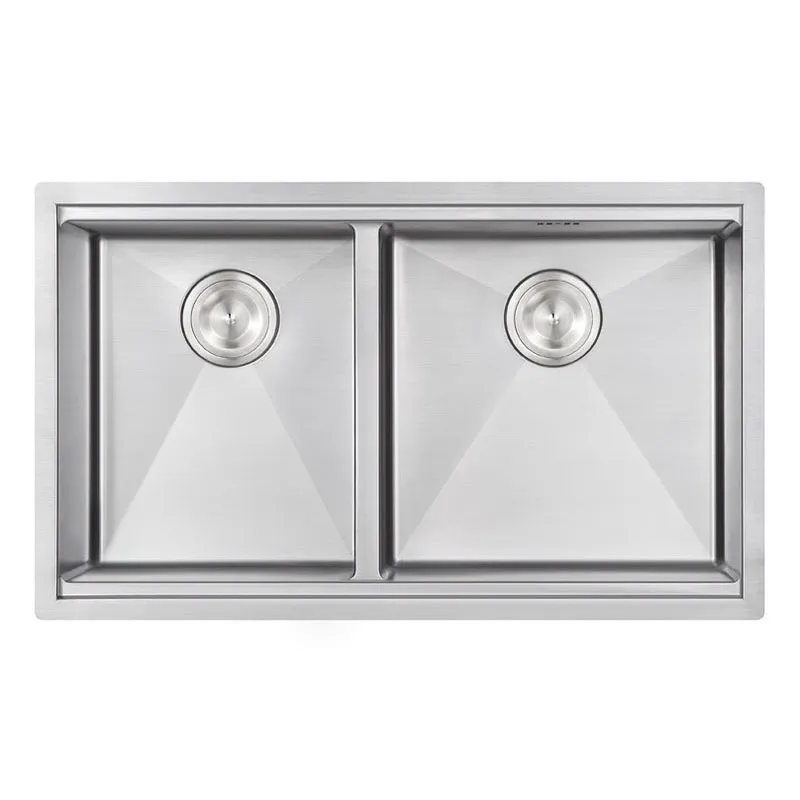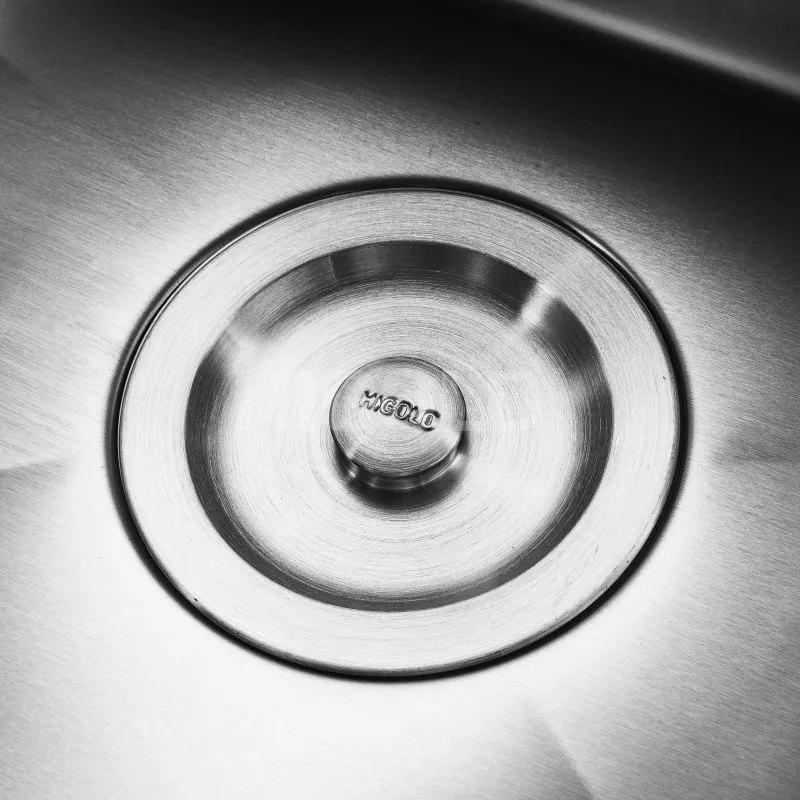• Nach der Installation sollte der tägliche Gebrauch mit Wasser simuliert werden, um eventuelle Undichtigkeiten an den Verbindungsstellen zu überprüfen.
• Sollten leichte Undichtigkeiten festgestellt werden, reparieren Sie umgehend die Dichtung oder setzen Sie die Fugendichtung neu ein.
Häufige Verbraucherirrtümer über Undichtigkeiten bei Unterbauspülen aus Edelstahl1. Der irrtümliche Glaube, dass Edelstahl automatisch Leckagen verhindertIn Wirklichkeit beeinflusst das Material des Spülbeckens nur die Korrosionsbeständigkeit; Undichtigkeiten hängen in erster Linie von der Dichtung und der Ausführung der Verbindungen ab.2. Der irrtümliche Glaube, dass Dichtmittel unnötig sei

Manche Leute glauben, dass Klammern zur Befestigung ausreichen, aber ohne Dichtmittel können an den Verbindungsstellen trotzdem Undichtigkeiten auftreten.
3. Vernachlässigung des Abflussrohranschlusses
Selbst wenn das Waschbecken selbst fachgerecht installiert ist, können dennoch Lecks auftreten, wenn das Abflussrohr nicht ordnungsgemäß abgedichtet ist.
4. Vorausgesetzt, die routinemäßige Reinigung beeinträchtigt die Dichtung nicht.
Starke Säuren und Laugen sowie Bleichmittel verringern bei längerem Kontakt mit dem Dichtmittel dessen Wasserdichtigkeit.
Muss eine Unterbauspüle aus Edelstahl abgedichtet werden?
Ja, Edelstahl
Unterbauspülen
Sie sind von Natur aus korrosionsbeständig und nicht leicht dicht, das Hauptrisiko für Leckagen entsteht jedoch durch unsachgemäße Installation oder eine defekte Dichtung. Daher ist eine ordnungsgemäße Abdichtung während der Installation unerlässlich.Durch korrekte Installation, Auswahl geeigneter Dichtungsmaterialien, regelmäßige Überprüfung der Anschlüsse und fachgerechte Wartung können Haushalte Leckagen wirksam verhindern und die langfristige Stabilität, Sicherheit und Langlebigkeit ihrer Unterbauspülen aus Edelstahl gewährleisten.Für Küchen, bei denen Sauberkeit, Ästhetik und effiziente Nutzung im Vordergrund stehen,
Unterbau
Edelstahlspülen sind nicht nur praktikabel zu installieren, sondern bei ordnungsgemäßer Abdichtung auch sicher und zuverlässig.
Besteht das Produktsortiment von Higold ausschließlich aus Spülbecken?
Higold ist zwar vor allem für seine Edelstahlspülen bekannt, produziert aber auch Küchenarmaturen und passende Beschläge. Alle Produkte werden nach demselben hohen Qualitätsstandard im ODM-Verfahren gefertigt und zeichnen sich durch innovative Designs und wettbewerbsfähige Preise aus. Großhändler und Distributoren können komplette Küchenlösungen von einem einzigen Anbieter beziehen und so Zeit und Kosten sparen. Unsere Fabrik gewährleistet gleichbleibende Qualität in allen Produktkategorien.
Therefore, stainless steel undermount sinks inherently possess high strength and corrosion resistance, providing a good foundation for leak prevention.

Will Stainless Steel Undermount Sinks Leak?
From the perspective of material and structure, undermount stainless steel sinks inherently have good waterproof performance. As long as the sink material is qualified and the sink body has no cracks, it will not leak due to the sink itself during daily use.
However, leaks in stainless steel undermount sinks mostly occur at the following points:
1. Sealant Failure
• Waterproof sealant is typically used to fill the interface between the countertop and the sink during installation.
• Aging, cracking, or improper use of the sealant can lead to leaks at the interface.
2. Loose Mounting Brackets
• Undermount sinks are secured with clips and brackets. If the installation is not secure or the brackets loosen over time, uneven stress on the sink can create tiny gaps, causing leaks.
3. Uneven Countertop or Defects
• Uneven or damaged countertop edges can prevent the undermount stainless steel sink from fitting completely, affecting the seal.
4. Water Pipe Connection Problems
• Improperly installed or poorly sealed drain pipe connections can cause leaks, which may be mistaken for leaks in the sink itself.
5. Improper Cleaning or Use
• Prolonged use of bleach or strong acid/alkali cleaners can corrode the sealant, reducing its waterproof performance.
• Excessive mechanical friction or accidental impact to the sink rim can also damage the seal.
In summary, leaks in stainless steel undermount sinks primarily stem from installation and connection issues, rather than defects in the sink material itself.

Does a stainless steel undermount sink require sealing?
The answer is yes: Stainless steel undermount sinks must be sealed. Sealing not only prevents leaks but also protects the countertop and sink for long-term use.
1. The Role of Sealing
• Prevents water from seeping under the countertop, avoiding moisture, swelling, or mold.
• Prevents water accumulation at the sink connection, reducing bacterial growth and odors.
• Improves the overall stability of the sink, ensuring even stress on the clips and supports.
2. Sealing Material Selection
• Neutral silicone or a dedicated waterproof sealant is recommended, as it is water-resistant, temperature-resistant, and has strong adhesion.
• Avoid using adhesives containing acids, alkalis, or chlorine, as these can corrode the stainless steel or countertop material.
3. Sealing Construction Principles
• The sink edge should be flush with the countertop, and sealant should be applied evenly to the joint.
• The sealant thickness should be moderate, ensuring waterproofing while avoiding affecting the sink's stability.
• The sealant should be fully cured to prevent leakage if used before it is completely dry.
Therefore, sealing is a crucial step in preventing leaks in undermount stainless steel sinks.
Stainless Steel Undermount Sink: What are the Installation Steps?
Proper installation directly affects the risk of leaks and the sink's lifespan.
1. Countertop Preparation
• Clean the underside of the countertop and the sink edge, ensuring they are free of dust and oil.
• Accurately measure the countertop opening dimensions to ensure a proper fit for the sink.
2. Sink Fixing
• Secure the sink to the countertop using dedicated clips or brackets.
• Distribute the fixing points evenly to ensure balanced force on the sink and prevent wobbling.
3. Sealing Construction
• Apply waterproof sealant evenly to the sink edge.
• Press the sink firmly against the countertop, ensuring the sealant is completely filled.
• Remove excess sealant and keep the joint clean.
4. Drain Pipe Connection
• Use a sealing ring or special adhesive when installing the drain pipe joint to ensure a tight seal.
• Conduct a leak test after installation to confirm there is no water seepage.
5. Curing and Testing
• Allow the sealant to fully cure according to the instructions, typically requiring at least 24 hours.
• Clean or use only after curing to ensure optimal waterproof performance.

Stainless Steel Undermount Sink: Daily Maintenance and Leak Prevention Measures
1. Keep Joints Dry
• Wipe the sink edges and countertop dry after each use to reduce prolonged moisture retention.
2. Regularly Inspect Sealant and Brackets
• Regularly check the sink joint sealant for aging, cracking, or peeling.
• Check the fixing clips and brackets for looseness and tighten them as needed.
3. Cleaning Material Selection
• Avoid using bleach or strong acid/alkali cleaners, as these may corrode the sealant.
• Use a neutral detergent and a soft cloth to clean the sink and surrounding countertop.
4. Preventing Mechanical Damage
• Avoid striking the sink rim or countertop with hard objects, as this may damage the seal and fixing structure.
5. Leakage Test
• After installation, simulate daily use with water and observe for any leaks at the joints.
• If slight leaks are found, promptly repair the sealant or reinstall the joint seal.
Common Consumer Misconceptions about Stainless Steel Undermount Sink Leaks
1. Mistakenly believing that stainless steel automatically prevents leaks
In reality, the sink material only affects corrosion resistance; leaks primarily depend on the seal and joint installation.
2. Mistakenly believing that sealant is unnecessary
Some people believe that clips are sufficient for fixing, but leaks can still occur at the joints without sealant.
3. Neglecting the Drain Pipe Connection
Even if the sink itself is securely installed, leaks can still occur if the drain pipe is not sealed properly.
4. Assuming Routine Cleaning Won't Affect the Seal
Strong acid and alkaline cleaners and bleach, when in prolonged contact with the sealant, will reduce its waterproof performance.
Does a Stainless Steel Undermount Sink Need to Be Sealed?
Yes, stainless steel undermount sinks are inherently corrosion-resistant and not easily leak-proof, but the main risk of leaks stems from improper installation or a failed seal. Therefore, proper sealing is essential during installation.
Through correct installation, selection of appropriate sealing materials, regular inspection of connections, and scientific maintenance, households can effectively prevent leaks and ensure the long-term stability, safety, and durability of their stainless steel undermount sinks.
For kitchens that prioritize cleanliness, aesthetics, and efficient use, undermount stainless steel sinks are not only feasible to install, but also safe and reliable when properly sealed.
Does Higold’s product line only include sinks?
While Higold is most famous for stainless steel sinks, we also produce kitchen faucets and related hardware solutions. All products follow the same high-quality ODM approach, offering innovative designs and competitive pricing. Wholesale buyers and distributors can purchase complete kitchen solutions from one supplier, saving time and cost. Our factory ensures consistent quality across all product categories.
5. Dichtigkeitsprüfung

